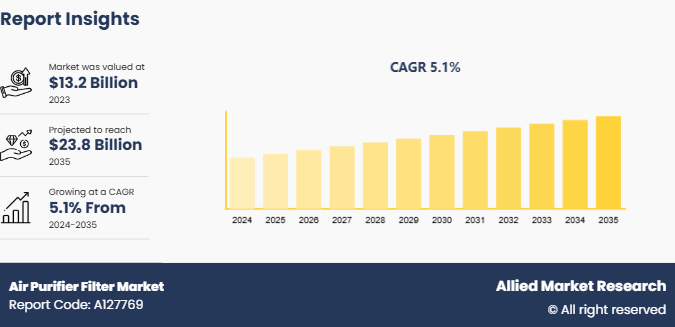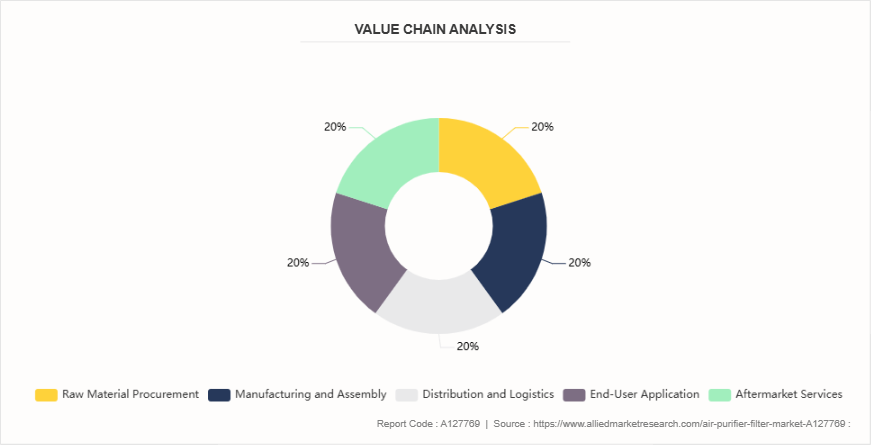Air Purifier Filter Market Research, 2035
Market Introduction and Definition
The global air purifier filter market size was valued at $13.2 billion in 2023, and is projected to reach $23.8 billion by 2035, growing at a CAGR of 5.1% from 2024 to 2035. An air purifier filter is a core component of air purifiers, designed to trap and remove airborne pollutants, including dust, pollen, smoke, odors, bacteria, and volatile organic compounds (VOCs) . These filters are made from specialized materials such as HEPA (High-Efficiency Particulate Air) , activated carbon, or electrostatic fibers, each tailored to target specific contaminants. A key driver for the air purifier filter market is the rising awareness of indoor air pollution and its adverse health effects. Increased urbanization, coupled with industrial emissions and rising cases of respiratory ailments such as asthma and allergies, has heightened the demand for air purification solutions. Furthermore, government regulations promoting better air quality standards and technological advancements in filtration efficiency are fueling the adoption of air purifier filters globally.

Key Takeaways
- The air purifier filter market study covers 20 countries. The research includes a segment analysis of each country in terms of value ($Billion) for the forecast period 2024-2035.
- More than 1, 500 product literature, industry releases, annual reports, and other such documents of major industry participants along with authentic industry journals, trade associations' releases, and government websites have been reviewed for generating high-value industry insights.
- The study integrated high-quality data, professional opinions and analysis, and critical independent perspectives. The research approach is intended to provide a balanced view of global markets and to assist stakeholders in making educated decisions in order to achieve their most ambitious growth objectives.
Key market dynamics
- Rise in awareness of the harmful effects of indoor air pollution has emerged as a significant driver for the air purifier filter market expansion. Studies have linked poor indoor air quality to respiratory illnesses, allergies, and other health conditions. Public campaigns and initiatives emphasizing the importance of clean indoor environments are prompting consumers to invest in air purifiers with advanced filters, thereby fueling growth of air purifier filter industry.
- Rapid urbanization and industrialization are leading to a significant decline in air quality in cities worldwide. Pollutants such as fine dust, smoke, and harmful gases are making urban residents more aware of the need for air purification solutions. Air purifier filters are increasingly being seen as an essential tool to combat these pollutants, particularly in regions with high population densities and worsening environmental conditions.
- The increasing prevalence of respiratory diseases, such as asthma, bronchitis, and allergies, is a major driver of the air purifier filter market. Vulnerable populations, including children, the elderly, and individuals with pre-existing health conditions, are particularly at risk. As a result, households and healthcare facilities are adopting air purifiers to create cleaner indoor environments, significantly boosting the air purifier filter market demand.
- One of the major challenges faced by the air purifier filter market is the high cost of maintenance and filter replacement. While air purifiers are becoming more affordable, the recurring expense of replacing filters, especially in high-performance systems, can deter price-sensitive consumers. This issue is particularly significant in developing regions, where consumers may prioritize cost over advanced features, limiting air purifier filter market growth.

Value Chain Analysis
Each stage in the value chain contributes to the overall value of air purifier filter and influences factors such as pricing, quality, and customer satisfaction. Analyzing each step helps identify areas for improvement and opportunities for innovation in the market.
Raw Material Procurement
This involves sourcing materials such as fiberglass for HEPA filters, activated carbon, or nanofiber composites. Suppliers focus on providing high-quality, durable, and cost-effective materials to ensure efficient filtration performance.
Manufacturing and Assembly
Filter manufacturing includes designing, layering, and assembling materials into standardized or customized shapes. Advanced production techniques improve filtration efficiency and durability. Manufacturers often integrate automation to reduce costs and ensure consistent quality.
Distribution and Logistics
Filters are distributed via wholesale and retail channels, including e-commerce platforms. Efficient logistics ensure timely delivery to meet demand. Regional distributors play a crucial role in supplying filters to residential, commercial, and industrial sectors, maintaining adequate inventory levels.
End-User Application
End-users install air purifier filters in homes, offices, and industries to improve air quality. Residential applications dominate, while commercial and industrial users seek advanced filters for compliance with air quality regulations.
Aftermarket Services
This step includes maintenance, replacement, and disposal of used filters. Companies provide support for filter replacements to ensure optimal performance.
Market Segmentation
The air purifier filter market is segmented into type, application, distribution channel, and region. On the basis of type, the market is segregated into HEPA filters, activated carbon filters, ionic filters, UV light filters, and electrostatic filters. On the basis of application, the market is classified into commercial and residential. On the basis of distribution channel, the market is bifurcated into the online and offline. By region, the market is analyzed across North America, Europe, Asia-Pacific, LAMEA.
Regional Market Outlook
Region wise, North America region held the major air purifier filter market share in 2023. With the rise in awareness of the health risks associated with exposure to airborne contaminants, including fine particulate matter (PM2.5) , allergens, smoke, and volatile organic compounds (VOCs) , consumers are investing in air purification systems. This trend is especially prominent in urban areas where industrial emissions, vehicle exhaust, and wildfire smoke have significantly impacted air quality. Furthermore, the growing prevalence of respiratory conditions such as asthma, bronchitis, and chronic obstructive pulmonary disease (COPD) has heightened the demand for advanced air purifier filters in residential and healthcare settings.
Industry Trends
- Rise in adoption of smart filters in air purifiers is a notable trend, as these filters integrate with advanced technologies such as IoT and AI. These filters are equipped with sensors that provide real-time data on indoor air quality and notify users about the need for filter replacement. They can seamlessly connect to smart home ecosystems, offering users greater convenience and control over air purification. With the growing inclination toward smart home solutions and connected devices, the demand for smart air purifier filters is expected to accelerate.
- Moreover, there is an increase in focus on the development of eco-friendly and recyclable air purifier filters to address environmental concerns. Manufacturers are using biodegradable materials and sustainable processes to create filters that minimize environmental impact. These innovations align with global initiatives to reduce waste and pollution. The trend is gaining traction as environmentally conscious consumers prefer products that combine functionality with sustainability, driving the market growth for such filters.
- The demand for portable air purifiers has been growing, leading to advancements in compact and efficient filters. These portable filters are designed to be lightweight, easy to replace, and highly effective, catering to consumers looking for flexible air purification solutions. Portable purifiers are increasingly used in cars, offices, and during travel, making them a preferred choice for people seeking clean air on the go. This trend reflects the growing consumer preference for convenience and mobility in air purification.
Competitive Landscape
The major players operating in the air purifier filter market include Honeywell International Inc., 3M Company, Daikin Industries, Ltd., Dyson Ltd., LG Electronics Inc., Panasonic Corporation, Sharp Corporation, Koninklijke Philips N.V., Blueair AB, and IQAir.
Key Benefits For Stakeholders
- This report provides a quantitative analysis of the market segments, current trends, estimations, and dynamics of the air purifier filter market analysis from 2024 to 2035 to identify the prevailing air purifier filter market opportunities.
- The market research is offered along with information related to key drivers, restraints, and opportunities.
- Porter's five forces analysis highlights the potency of buyers and suppliers to enable stakeholders make profit-oriented business decisions and strengthen their supplier-buyer network.
- In-depth analysis of the air purifier filter market segmentation assists to determine the prevailing market opportunities.
- Major countries in each region are mapped according to their revenue contribution to the global market.
- Market player positioning facilitates benchmarking and provides a clear understanding of the present position of the market players.
- The report includes the analysis of the regional as well as global air purifier filter market trends, key players, market segments, application areas, and market growth strategies.
Air Purifier Filter Market Report Highlights
| Aspects | Details |
| Market Size By 2035 | USD 23.8 Billion |
| Growth Rate | CAGR of 5.1% |
| Forecast period | 2024 - 2035 |
| Report Pages | 300 |
| By Type |
|
| By Application |
|
| By Distribution Channel |
|
| By Region |
|
| Key Market Players | Daikin Industries, Ltd., Camfil AB, Honeywell International Inc., Philips N.V., LG Electronics Inc., Sharp Corporation, Whirlpool Corporation, Blueair AB, Dyson Ltd., 3M Company |
The global air purifier filter market was valued at $13.2 billion in 2023, and is projected to reach $23.8 billion by 2035, growing at a CAGR of 5.1% from 2024 to 2035.
The air purifier filter market is segmented into type, application, distribution channel, and region. On the basis of type, the market is segregated into HEPA filters, activated carbon filters, ionic filters, UV light filters, and electrostatic filters. On the basis of application, the market is classified into commercial and residential. On the basis of distribution channel, the market is bifurcated into the online and offline. By region, the market is analyzed across North America, Europe, Asi
North America is the largest regional market for air purifier filter
The major players operating in the air purifier filter market include Honeywell International Inc., 3M Company, Daikin Industries, Ltd., Dyson Ltd., LG Electronics Inc., Panasonic Corporation, Sharp Corporation, Koninklijke Philips N.V., Blueair AB, and IQAir.
The global air purifier filter market report is available on request on the website of Allied Market Research.
Loading Table Of Content...



